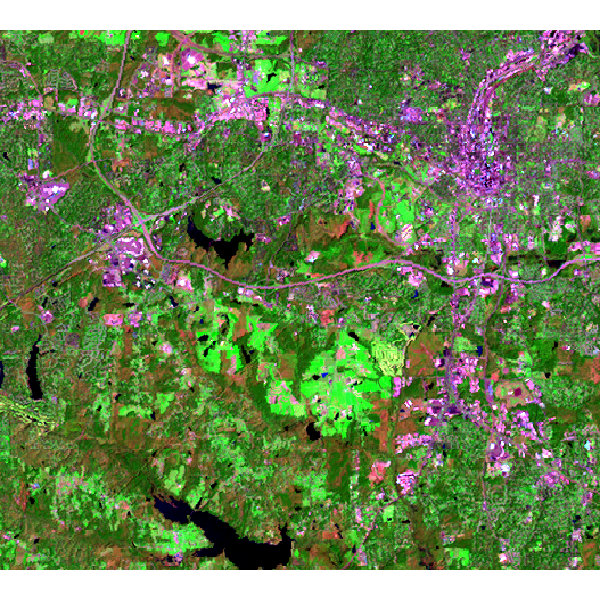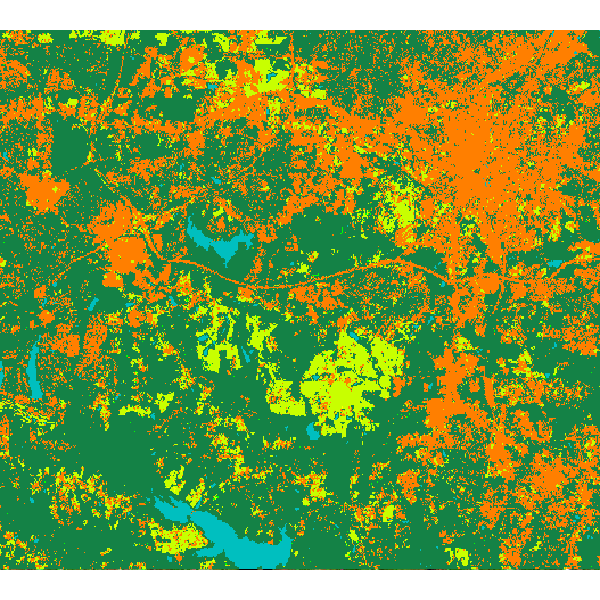
r.learn.ml represents a front-end to the scikit learn python package. The module enables scikit-learn classification and regression models to be applied to GRASS GIS rasters that are stored as part of an imagery group group or specified as individual maps in the optional raster parameter. Several commonly used classifiers and regressors are exposed in the GUI and the choice of classifier is set using the classifier parameter. For more details relating to the classifiers, refer to the scikit learn documentation. The following classification and regression methods are available:
The Classifier parameters tab provides access to the most pertinent parameters that affect the previously described algorithms. The scikit-learn classifier defaults are generally supplied, and some of these parameters can be tuning using a grid-search by inputting multiple parameter settings as a comma-separated list. This tuning can also be accomplished simultaneously with nested cross-validation by also settings the cv option to > 1. The parameters consist of:
In addition to model fitting and prediction, feature selection can be performed using the -f flag. The feature selection method employed is based on Brenning et al. (2012) and consists of a custom permutation-based method that can be applied to all of the classifiers as part of a cross-validation. The method consists of: (1) determining a performance metric on a test partition of the data; (2) permuting each variable and assessing the difference in performance between the original and permutation; (3) repeating step 2 for n_permutations; (4) averaging the results. Steps 1-4 are repeated on each k partition. The feature importance represent the average decrease in performance of each variable when permuted. For binary classifications, the AUC is used as the metric. Multiclass classifications use accuracy, and regressions use R2.
Cross validation can be performed by setting the cv parameters to > 1. Cross-validation is performed using stratified kfolds, and multiple global and per-class accuracy measures are produced depending on whether the response variable is binary or multiclass, or the classifier is for regression or classification. The cvtype parameter can also be changed from 'non-spatial' to either 'clumped' or 'kmeans' to perform spatial cross-validation. Clumped spatial cross-validation is used if the training pixels represent polygons, and then cross-validation will be effectively performed on a polygon basis. Kmeans spatial cross-validation will partition the training pixels into n_partitions by kmeans clustering of the pixel coordinates. These partitions will then be used for cross-validation, which should provide more realistic performance measures if the data are spatially correlated. If these partioning schemes are not sufficient then a raster containing the group_ids of the partitions can be supplied using the group_raster option.
Although tree-based classifiers are insensitive to the scaling of the input data, other classifiers such as linear models may not perform optimally if some predictors have variances that are orders of magnitude larger than others. The -s flag adds a standardization preprocessing step to the classification and prediction to reduce this effect. Additionally, most of the classifiers do not perform well if there is a large class imbalance in the training data. Using the -b flag balances the training data by weighting of the minority classes relative to the majority class. This does not apply to the Naive Bayes or LinearDiscriminantAnalysis classifiers.
Non-ordinal, categorical predictors are also not specifically recognized by scikit-learn. Some classifiers are not very sensitive to this (i.e. decision trees) but generally, categorical predictors need to be converted to a suite of binary using onehot encoding (i.e. where each value in a categorical raster is parsed into a separate binary grid). Entering the indices (comma-separated) of the categorical rasters as they are listed in the imagery group as 0...n in the categorymaps option will cause onehot encoding to be performed on the fly during training and prediction. The feature importances are returned as per the original imagery group and represent the sum of the feature importances of the onehot-encoded variables. Note: it is important that the training samples all of the categories in the rasters, otherwise the onehot-encoding will fail when it comes to the prediction.
The module also offers the ability to save and load a classification or regression model (save_model=name[.gz]). Note that the model file size can become quite large; when using a supported filename extensions (incl. '.gz', '.bz2', '.xz' or '.lzma') the model file will be automatically compressed. Saving and loading a model allows a model to be fitted on one imagery group, with the prediction applied to additional imagery groups. This approach is commonly employed in species distribution or landslide susceptibility modelling whereby a classification or regression model is built with one set of predictors (e.g. present-day climatic variables) and then predictions can be performed on other imagery groups containing forecasted climatic variables.
For convenience when performing repeated classifications using different classifiers or parameters, the training data can be saved to a csv file using the save_training option. This data can then be loaded into subsequent classification runs, saving time by avoiding the need to repeatedly query the predictors.
r.learn.ml uses the "scikit-learn" machine learning python package along with the "pandas" package. These packages need to be installed within your GRASS GIS Python environment. For Linux users, these packages should be available through the linux package manager. For MS-Windows users using a 64 bit GRASS, the easiest way of installing the packages is by using the precompiled binaries from Christoph Gohlke and by using the OSGeo4W installation method of GRASS, where the python setuptools can also be installed. You can then use 'easy_install pip' to install the pip package manager. Then, you can download the NumPy+MKL and scikit-learn .whl files and install them using 'pip install packagename.whl'. For MS-Windows with a 32 bit GRASS, scikit-learn is available in the OSGeo4W installer.
r.learn.ml is designed to keep system memory requirements relatively low. For this purpose, the rasters are read from the disk row-by-row, using the RasterRow method in PyGRASS. This however does not represent an efficient volume of data to pass to the classifiers, which are mostly multithreaded. Therefore, groups of rows specified by the rowincr parameter are passed to the classifier, and the reclassified image is reconstructed and written row-by-row back to the disk. rowincr=25 should be reasonable for most systems with 4-8 GB of ram. The row-by-row access however results in slow performance when sampling the imagery group to build the training data set when providing a raster as the trainingmap. Instead, the default behaviour is to read each predictor into memory at a time. If this still exceeds the system memory then the -l flag can be set to write each predictor to a numpy memmap file, and classification/regression can then be performed on rasters of any size irrespective of the available memory.
Many of the classifiers involve a random process which can causes a small amount of variation in the classification results, out-of-bag error, and feature importances. To enable reproducible results, a seed is supplied to the classifier. This can be changed using the randst parameter.
Here we are going to use the GRASS GIS sample North Carolina data set as a basis to perform a landsat classification. We are going to classify a Landsat 7 scene from 2000, using training information from an older (1996) land cover dataset.
Landsat 7 (2000) bands 7,4,2 color composite example:

Note that this example must be run in the "landsat" mapset of the North Carolina sample data set location.
First, we are going to generate some training pixels from an older (1996) land cover classification:
g.region raster=landclass96 -p r.random input=landclass96 npoints=1000 raster=landclass96_roi
Then we can use these training pixels to perform a classification on the more recently obtained landsat 7 image:
r.learn.ml group=lsat7_2000 trainingmap=landclass96_roi output=rf_classification \ classifier=RandomForestClassifier n_estimators=500 # copy category labels from landclass training map to result r.category rf_classification raster=landclass96_roi # copy color scheme from landclass training map to result r.colors rf_classification raster=landclass96_roi r.category rf_classification
Random forest classification result:

Thanks for Paulo van Breugel and Vaclav Petras for testing.
Brenning, A. 2012. Spatial cross-validation and bootstrap for the assessment of prediction rules in remote sensing: the R package 'sperrorest'. 2012 IEEE International Geoscience and Remote Sensing Symposium (IGARSS), 23-27 July 2012, p. 5372-5375.
Scikit-learn: Machine Learning in Python, Pedregosa et al., JMLR 12, pp. 2825-2830, 2011.
Last changed: $Date$